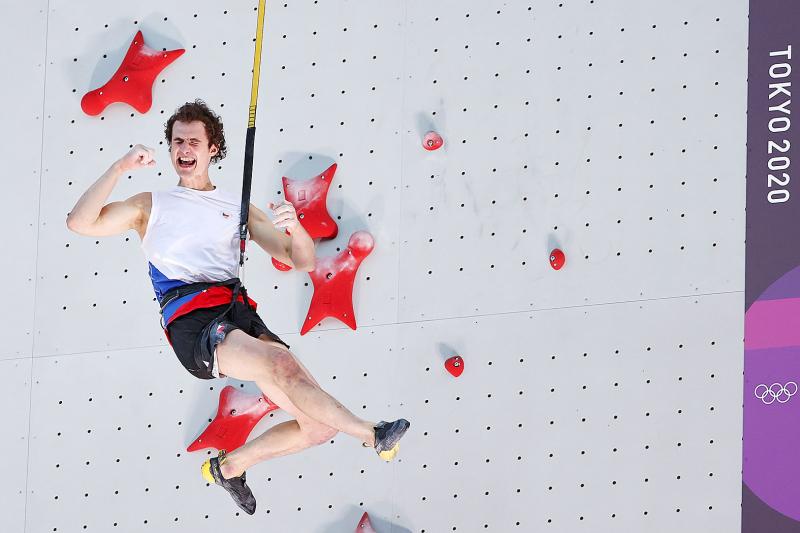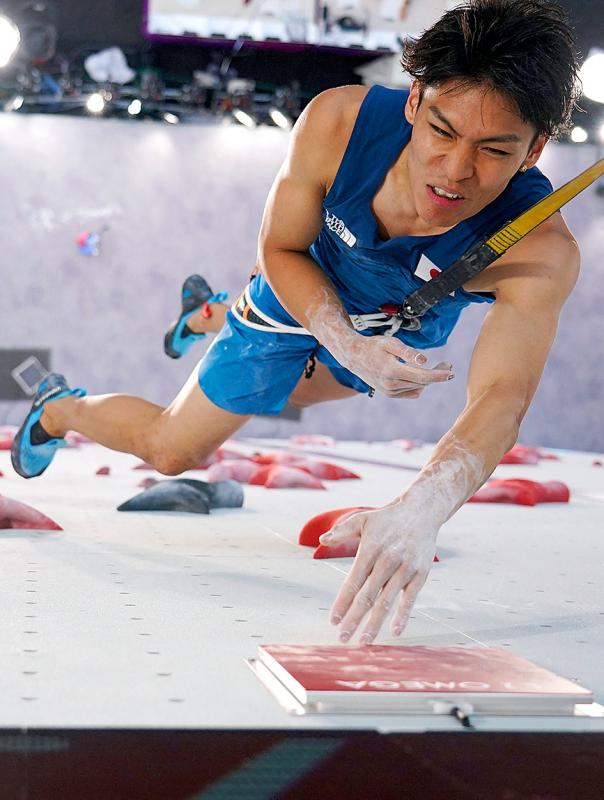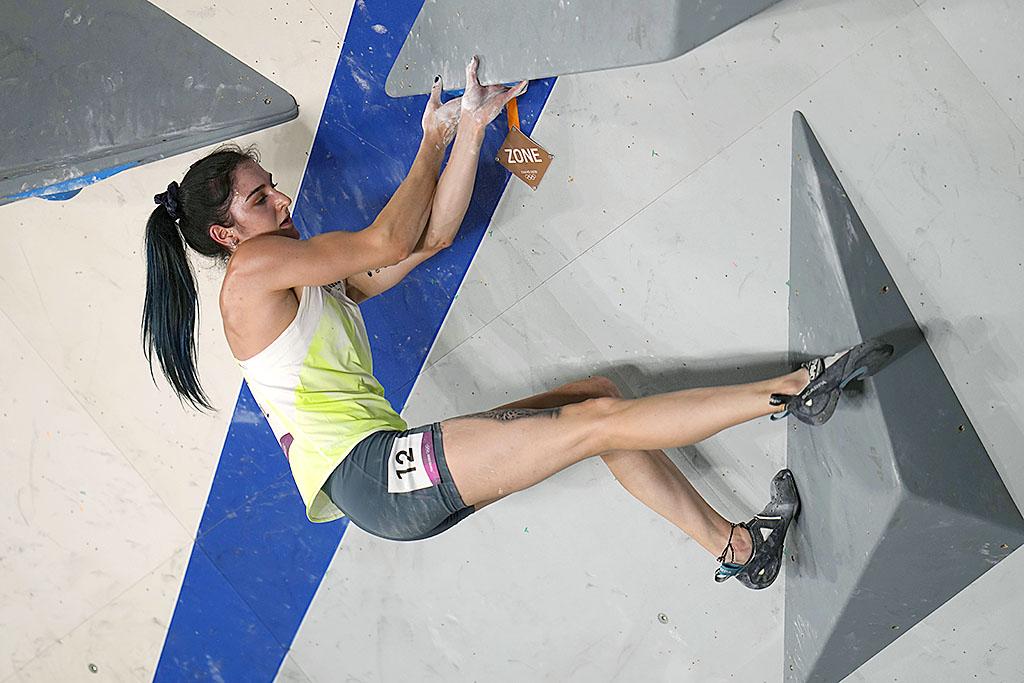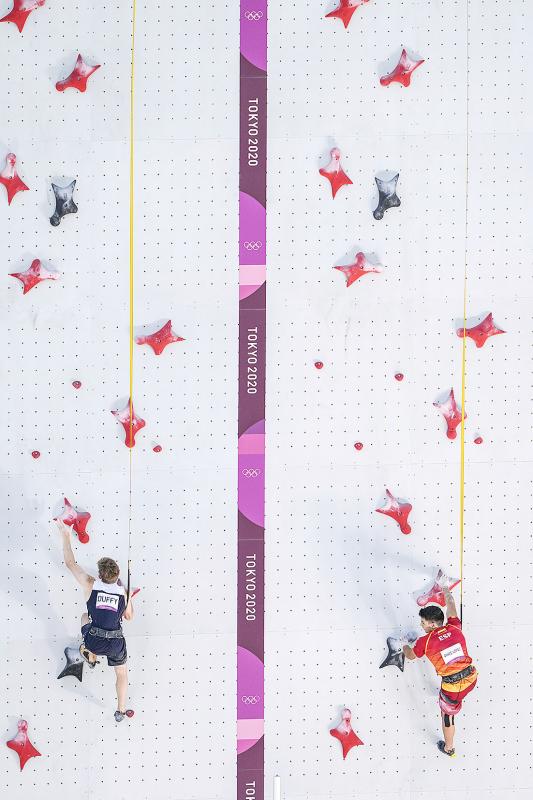Basketball, baseball, tennis — the list goes on and on of Olympic sports nearly everyone has at least tried before. Watch those athletes in Tokyo on the TV and somewhere in the back of your mind, it’s easy to think: I could probably do that.
Seeing sport climbers hang one-handed from their fingertips or upside down from one foot wedged into a crevice ushers in a different kind of response: Yeah, no way I could do that.
Sport climbing has made its Olympic debut, giving the world a chance to see just how physically demanding it can be. A mix of speed, strength and agility, the sport has opened a few eyes through two days of qualifying. It will become even more intense with the finals, which started with the men on Thursday.

Photo: EPA-EFE
A BRIEF HISTORY
Climbing has been around since early man looked up at a rock wall and thought: Wonder what it would be like to climb that?
As with almost every other athletic endeavor, it turned into a competition.

Photo: AFP
Sport climbing first took hold in the 1980s on outdoor walls and moved inside late in the decade to avoid having a negative environmental impact. The first world championships were held a decade later and the International Federation of Sport Climbing was founded in 2007, providing the sport more structure.
The sport has climbed in popularity in recent years with the success of the documentary Free Solo, the social media prowess of its climbers and a TV deal with ESPN to broadcast World Cup events.
The sport has kept some of its laid-back vibe. But the competitions have given climbers a different kind of outlet and the financial means to continue pursuing the sport they love.

Photo: AP
THE FORMAT
Sport climbing’s Olympic program is broken down into three disciplines: speed, bouldering and lead.
Lead is a lot like what people see on indoor recreational walls, only much, much harder. The scoring is simple, too: climbers have six minutes to see who can make it the highest on the 45-meter wall. Any ties are broken by who did it fastest.

Photo: AP
Bouldering is a set of four “problems” climbers have to try solving in four minutes each. The problems can include overhangs, places where climbers have to wedge themselves between holds and spots where going upside down is the only option to keep climbing. Climbers earn points for reaching each top and get partial points for reaching various zones up the walls.
The setup for speed is simple: climbers race side by side up a 45-meter wall dotted with standardized holds.
Speed was a controversial addition to the sport’s Olympic debut because it requires a different skill set than the other two disciplines. As Britain’s Shauna Coxsey put it, having speed is like asking Usain Bolt to add the marathon and hurdles to his sprint events.
The IOC is handing out just two climbing medals in Tokyo — one each for men and women — and wanted a fast-moving element to the sport in its debut, so speed was included in the format. Speed will be a separate event at the 2024 Paris Games.
SCORING
Scoring is a combination of each climber’s place in the three disciplines. The places are multiplied together and lowest total wins. An example: if a climber places first in boulder, second in lead, 10th in speed, their total would be 20.
The scoring format gives winners of any of the three disciplines a huge advantage since their total will be multiplied by one, allowing room to have a bad finish in one discipline.
Many of the top lead and boulder climbers are not nearly as proficient at speed climbing as the speed specialists, so their goal is to win at least one of the other disciplines to have a chance in the combined.

April 28 to May 4 During the Japanese colonial era, a city’s “first” high school typically served Japanese students, while Taiwanese attended the “second” high school. Only in Taichung was this reversed. That’s because when Taichung First High School opened its doors on May 1, 1915 to serve Taiwanese students who were previously barred from secondary education, it was the only high school in town. Former principal Hideo Azukisawa threatened to quit when the government in 1922 attempted to transfer the “first” designation to a new local high school for Japanese students, leading to this unusual situation. Prior to the Taichung First

The Ministry of Education last month proposed a nationwide ban on mobile devices in schools, aiming to curb concerns over student phone addiction. Under the revised regulation, which will take effect in August, teachers and schools will be required to collect mobile devices — including phones, laptops and wearables devices — for safekeeping during school hours, unless they are being used for educational purposes. For Chang Fong-ching (張鳳琴), the ban will have a positive impact. “It’s a good move,” says the professor in the department of

On April 17, Chinese Nationalist Party (KMT) Chairman Eric Chu (朱立倫) launched a bold campaign to revive and revitalize the KMT base by calling for an impromptu rally at the Taipei prosecutor’s offices to protest recent arrests of KMT recall campaigners over allegations of forgery and fraud involving signatures of dead voters. The protest had no time to apply for permits and was illegal, but that played into the sense of opposition grievance at alleged weaponization of the judiciary by the Democratic Progressive Party (DPP) to “annihilate” the opposition parties. Blamed for faltering recall campaigns and faced with a KMT chair

Article 2 of the Additional Articles of the Constitution of the Republic of China (中華民國憲法增修條文) stipulates that upon a vote of no confidence in the premier, the president can dissolve the legislature within 10 days. If the legislature is dissolved, a new legislative election must be held within 60 days, and the legislators’ terms will then be reckoned from that election. Two weeks ago Taipei Mayor Chiang Wan-an (蔣萬安) of the Chinese Nationalist Party (KMT) proposed that the legislature hold a vote of no confidence in the premier and dare the president to dissolve the legislature. The legislature is currently controlled